|
A Miniature Radio Receiver for Police
Use
by Lawrence H. Smith, Radio Technician, Police
Department, Atlantic City, N. J.
FBI LAW ENFORCEMENT BULLETIN Date? probably 40s or
50s
Article Courtesy Glendale Police Museum, Glendale Arizona
The Atlantic City Police Department now has in successful use a tiny
radio receiving set concealed in a patrolman's cap over which he receives
all calls emanating from the headquarters transmitter. The receiver weighs
less than 2 ounces. Together with the batteries, antenna, and earpiece,
the weight is 6 Ounces. Including the cap and badge, the entire ensemble
weighs 15 ounces.
By using a special lightweight cap, with an aluminum or plastic badge,
together with a few contemplated changes in the design of the receiver, we
hope to soon cut this weight by approximately 3 ounces.
The receiver is in an aluminum case, 1 'V7/8 inches square and 1 inch
thick. It is concealed in the peak of the cap behind the badge. Operation
is from hearing-aid batteries located in the brim to
give equal weight distribution. The sound is carried to the ear by a small
Telex earpiece concealed in the brim to which is connected a short piece
of sound tubing which carries the voice outside the cap and into the ear.
Volume control is obtained by adjusting the tubing closer to the ear or
farther away.
Batteries and Tubes
The "A" battery used will give continuous operation for 7
hours, the "B" battery lasts from 7 to 10 8-hour days.
Four Raytheon subminiature tubes are utilized READ
THE PAGES BELOW FOR THE REST!
|
|
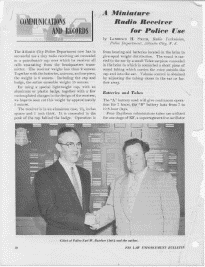
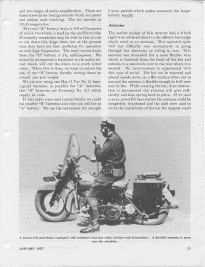
|
|
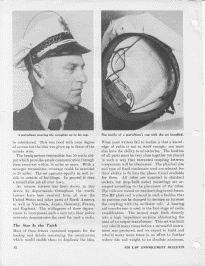
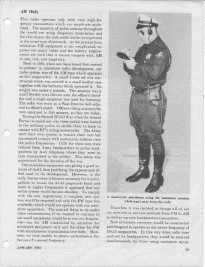
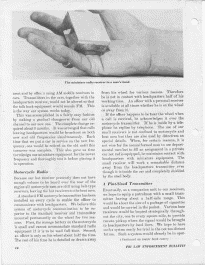
|
|
|
|
Radio Personality Raises Communication in
Loudoun County
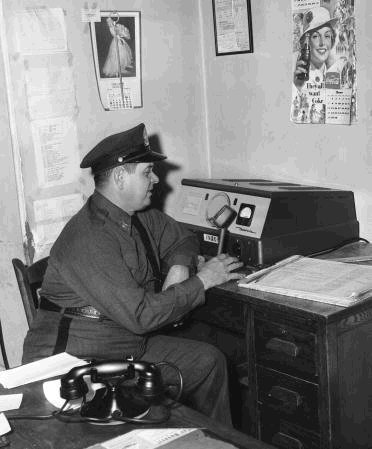
Sheriff Roger Powell Uses the Radio Equipment Donated by Arthur Godfrey.
Picture courtesy of The Winslow Williams Collection c/o The Thomas Balch Library, Leesburg, VA
(Loudoun County Sheriff’s Office - 04/06/07)The second week of April marks National Public Safety and Telecommunicators Week. The week is dedicated to the men and women who serve as public safety call takers and dispatchers.
The way public safety dispatchers communicate with Loudoun Deputies today can be traced back 50 years ago to a gift from popular radio personality, Arthur
Godfrey.
In a letter dated November 22, 1952, Roger F. Powell, who served as Loudoun’s Sheriff from 1952 to 1959, informed then County Chairman I.W. Baker that Arthur Godfrey had donated $2000 “to be used in installing a county police radio communication system.” The revelation of Godfrey’s name was controversial at the time as the radio personality had asked for his contribution to remain anonymous. Sheriff Powell was forced to release the radio stars
name after some supervisors declared there would be no budget increase requests for the Sheriff unless the identity of the donor was revealed. “No money for an extra man until you talk,” the board demanded according to one local newspaper.
Godfrey, who started his radio career in Baltimore in 1929, later joined Washington D.C.’s NBC affiliate. In 1942 his morning show could be heard on CBS’ flagship station, WABC in New York. Back in Loudoun County, Godfrey purchased the Beacon Hill Estate west of Leesburg, Virginia and commuted by plane from his farm to studios in New York City every Sunday night. Godfrey would affectionately refer to his land as ‘the old cow pasture’ on his radio show.
In the revelation letter to the Board of Supervisors, Sheriff Powell stated that he discussed with Godfrey issues within the Sheriff’s Office and the fact that two county tragedies had recently taken place: a robbery and shooting in Hillsboro and the Fox family murders. Powell told Godfrey that he would like to have a county police system “whereby all the emergency units, such as fire departments, rescue squads, and the game warden could be tied together as more efficient operating units”. Mr. Godfrey asked, “What will it cost?”
According to the letter, initial estimates for the radio system were in the range of $1200. In response to the figure Godfrey said, “one thousand or two thousand dollars, get busy, don’t let any moss grow on it. I’ll do that much for my people of Loudoun County.” The cost rose to $1600 before Godfrey donated a total of $2000 stating “we don’t want any dead spots in the system; (get) the kind of equipment that will do the job right.” Less than a month later on December 18, 1952, a headline in the Loudoun News proclaimed “Loudoun County Police Radio Station Goes On Air Today”.
Only a few years later, Godfrey continued his good will with the donation of a small portion of his land off of Old Waterford Road near Leesburg. The land was used by the Loudoun Sheriff’s Office to build a radio tower; greatly increasing the agency’s communications capabilities. Robert W. Legard, who served as Loudoun County Sheriff from 1964 to 1979, worked with Hankey’s Radio in Frederick, MD to erect a tower on the land. The tower broadcasted two low-band channels, one for the Sheriff’s Office and one for Loudoun Fire/Rescue. The tower still stands today but is no longer in use.
For several decades, Sheriff’s Offices across the state used the low-band frequency of 39.5 megacycles, which caused problems on busy weekends. On some evenings, Fauquier County, VA deputies and Loudoun deputies would compete for airtime when responding to calls. Because of the nature of low-band frequencies, which can skip great distances off of the atmosphere on clear nights, the radios would pick up radio traffic from law enforcement as far away as Bogalusa, Louisiana.
For nearly 40 years the dispatching system broadcast from the county jail on Church Street in Leesburg. In 1990 the needs of the Sheriff’s Office dispatch center outgrew the facility and moved to its current location on Courage Court. The dispatch office, today referred to as the Emergency Communications Center (ECC), employs over 40 dispatchers. In 2006, the staff handled over 390,000 9-1-1 and non-emergency calls.
In 2000 and after years of requests, current Loudoun County Sheriff Steve Simpson secured funding for Loudoun’s public safety community to finally upgrade to an 800 MHZ digital trunking system. The 11-channel system allows separate simultaneous channels for the agency’s specialty units and covers the entire county with few drop-out areas. A few years later Sheriff’s patrol cars were outfitted with mobile data terminals allowing deputies to turn in paperless reports from the front seat of their vehicles.
Godfrey was instrumental in the implementation of the public safety radio system in Loudoun County, but his good will did not end with the Sheriff’s Office. Over the years Godfrey donated an ambulance and the financing for an entire wing for Loudoun County Hospital. In 1960 Godfrey donated $200,000 from the sale of his 'old cow pasture' for the development of an airport. The area is now known as Leesburg Executive Airport at Godfrey Field.
Arthur Godfrey passed away in New York in 1983 and is buried in Union Cemetery only a few miles from his former Leesburg home.
The Loudoun County Sheriff’s Office was founded in 1757 and is currently celebrating their 250th anniversary.
(submitted by Albert LaFrance to SMECC) |
|
Hi Ed:
Likely you will not find much about Law Enforcement teletype in this
group, as we are primarily a military group. We specialize in military
communications.
There are some here who may have experience in law enforcement
teletype, myself included, but most do not.
However, what you are seeking in the way of Law Enforcement
Teletype comes under the heading of "NLETS" or
"LETS". NLETS
is the National Law Enforcement Teletype System, and there are
several components to it in each of teh 50 states and Canada.
There is also an INTERPOL affiliation.
NLETS is separate from NCIC - National Crime Information Center
which is run by the FBI.
In most states, NLETS is run by the states, and in many cases,
State Law Enforcement agencies oversee its' operation. These
agencies might include such as FDLE - Florida Dept of Law Enforcement,
or SLED - South Carolina Law Enforcement Division -- the organizations
who are authorized to grant Police Powers (via their various state
legislatures), to the many police departments within and under
their jurisdictions.
FWIW, there are 38,000 Police Depts in the US (PDs, SOs,
HPs, State Police, Constabularies, etc)...and each dept has at
least one NLETS terminal, with most having several. Big network!
Check out NLETS and "National Law Enforcement Teletype"
on Google, as there seems to be a fair amount of information
there of interest.
When I worked in law enforcement, the standard teletype
gear was the Model 28 ASR, some Model 32s, and later
a few model 33s, and finally computer terminals.
Every PD, SO and law enforcement agency had its' own
"Routing Indicator", including all US military Military Police
stations who were tied into NLETS. Today, NLETS is a
high speed, pretty efficient system which is often used to
pass BOLOs, RAP sheets and other police business on
suspects. BOLOs are essentially the old "APBs" and
stands for "Be On Look Out...." RAP Sheets are criminal
histories on individuals (in some cases, we had them as long as
21 pages on a single individual when I worked for the Brevard
County Sheriffs Office in Florida).
Hope this helps,
------------------------------------------------------------
While
NLETS is separate, it is firmly connected. One accesses NCIC through
normally a state connection, such as TCIC in TN, MULES in
Missouri
, etc, and then THROUGH NLETS to NCIC.
A
state/local user does not access NCIC directly, the pipe and parsing is
provided by NLETS.
The
state provides training, administration, etc to the end user agencies.
Going through TAC school was boring – until they showed us
administrative messaging. While now a days it is every day stuff, the fact
we could message back and forth to other agency TAC’s in the room, many
times cute female TAC’s was pretty cool – until the state director
came in and advised us that the control operator could see every message
in the state control center (same building where we were doing our
training).
Took
all the fun out of it.
The
first agency I was with had an ASR33 back in a hallway, but I never saw it
being used.
bbowerslists@gmail.com
-----
From:
CommCenter-1@yahoogroups.com [mailto:CommCenter-1@yahoogroups.com] On
Behalf Of NNN7DXB@aol.com
Sent: Monday, April 15,
2013 9:14 AM
To: CommCenter-1@yahoogroups.com
Subject: Re:
[CommCenter-1] need scanned material & stories for our law
enforcement...
NLETS
is separate from NCIC -
National
Crime
Information
Center
|
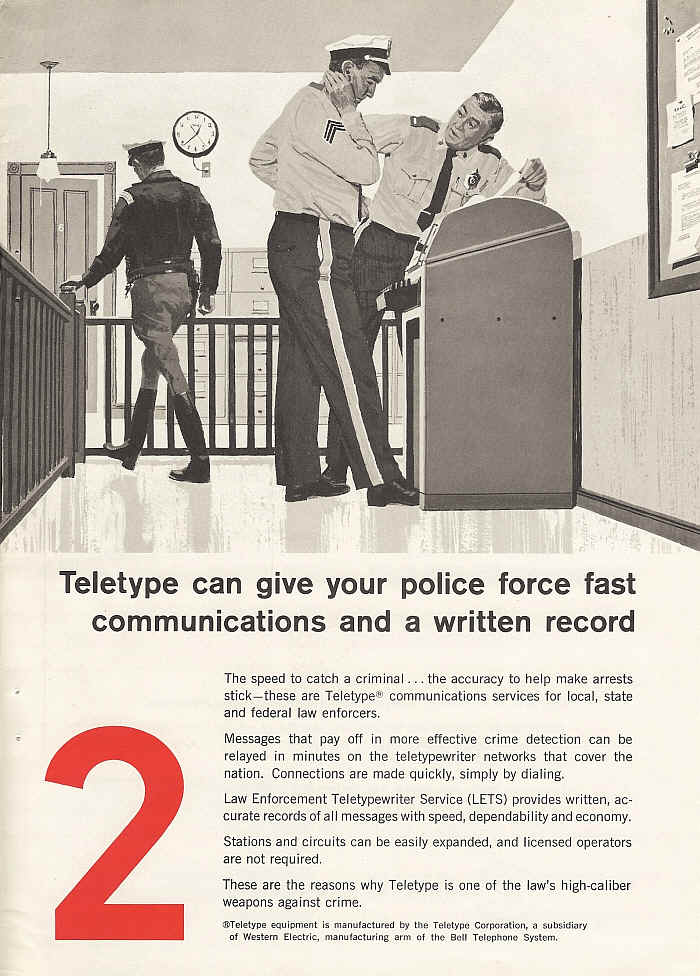
1963 Bell Public
Telephone Teletype Emergency Reporting Group Alerting ETV 6P Ad
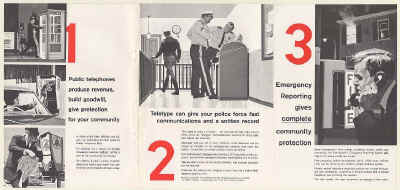
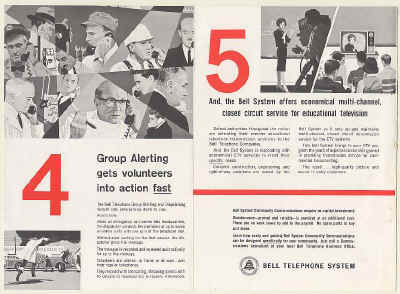
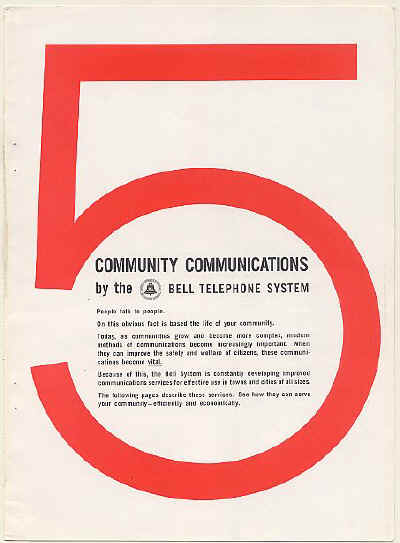
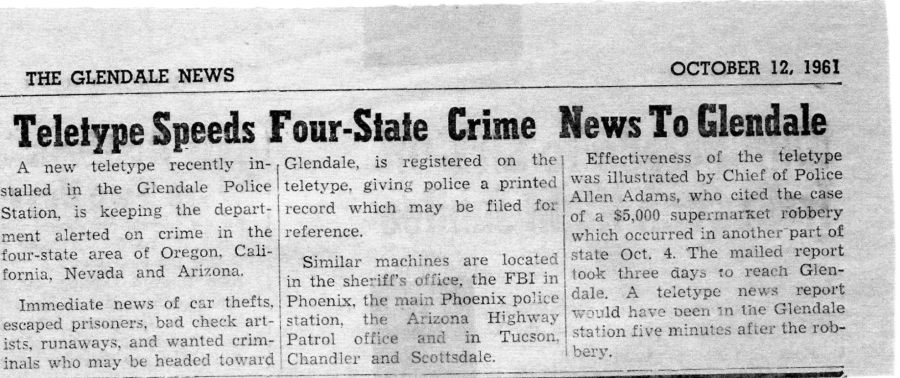
-
| THE
GLENDALE NEWS |
|
OCTOBER
12, 1981, |
|
Teletype
Speeds Four-State Crime News To Glendale |
| A
new teletype recently installed in the Glendale Police Station, is
keeping the department alerted on crime in the four-state area of
Oregon, California, Nevada and Arizona.
Immediate
news of car thefts, escaped prisoners, bad check artists. runaways,
and wanted criminals who maybe headed toward |
Glendale,
is registered on the teletype. giving police a printed record which
may be filed for reference.
Similar
machines are located in the sheriff's office, the FBI in Phoenix,
the main Phoenix police station, the Arizona Highway Patrol office
and in Tucson, Chandler and Scottsdale. |
Effectiveness
of the teletype was illustrated by Chief of Police Allen Adams
who cited the case of a 5,000 supermarket robbery which
occurred in another part of state Oct. 4. The mailed report took
three days to reach Glendale. A teletype news report
would have been seen in the Glendale station five
minutes after the robbery. |
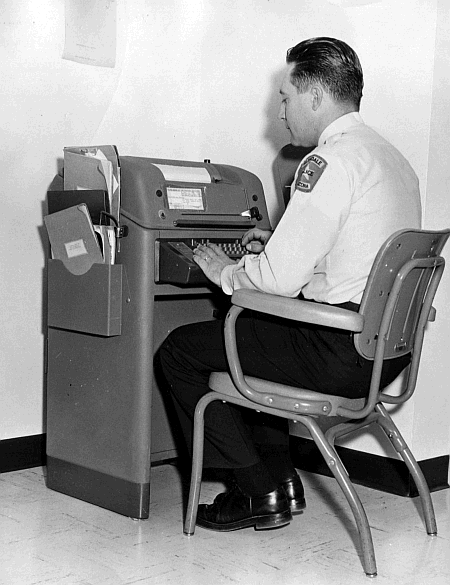
The
officer is Sal Vetrano, it is in the new station at 7119 n. 57 Dr. so it
would be around 1963 to 1969.Thats about all I can tell you about it
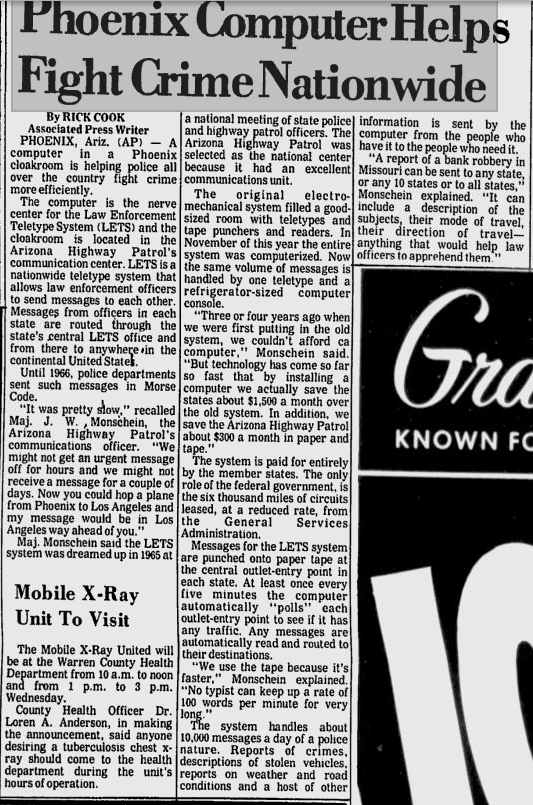
aug 23 1970 even appeared in 
|
Computer Controls
Police Teletype Net
Aug 23 1970 this article even appeared in Pak City Daily
News Aug 19 1970
|
Computer Controls
Police Teletype Net
By RICK COOK
Associated Press Writer
PHOENIX, Ariz. (AP) - A
computer in » Phoenix cloakroom
is helping police all over
the country fight crime more efficiently.
The computer is the nerve
center for the Law Enforcement
Teletype System (LETS) and
the cloakroom is located in the
Arizona Highway Patrol's communication
center. LETS is a nationwide
teletype system that
allows law enforcement officers
to send messages to each other.
Messages from officers in each
state are routed through the
state's central LETS office and
from there to anywhere in the
continental United States.
Until 1966, police departments
sent such messages in Morse
Code.
(no-
used paper tape
but was Baudot not MORSE!
- Ed Sharpe)
"It was pretty slow," recalled
Maj. J. W. Monschein, the Arizona
Highway Patrol's communications
officer. "We might not
get an urgent message off for
hours and we might not receive
a message for a couple of days.
Now you could hop a plane from
Phoenix to Los Angeles and my
message would be in Los Angeles
way ahead of you."
Maj. Monschein said the
LETS system was dreamed up
in 1965 at a national meeting of
state police and highway patrol
officers. The Arizona Highway
patrol was selected as the national
center because it had an
excellent communications unit.
The original electro-mechanical
system filled a good-sized
room with teletypes and tape
punchers and readers. In November
of this year the entire
system was computerized. Now
the same volume of messages is
handled by one teletype and a
|
refrigerator-sized computer console.
"Three or four years ago
when we were first putting in
the old system, we couldn't aftord
a computer," Monschein
said. "But technology has come
so far so fast that by installing
computer we actually save the
states about $1,500 a month over
the old system. In addition, we
save the Arizona Highway Patrol
about $300 a month in paper
and tape."
The system is paid for entirely
by the member states. The
only role of the federal government,
is the six thousand miles
of circuits leased, at a reduced
rate, from the General Services
Administration.
Messages for the LETS system
are punched onto paper
tape at the central outlet-entry
point in each state. At least
once every five minutes the
computer automatically "polls"
each outlet-entry point to see i*
it has any traffic. Any messages
are automatically read and
routed to their destinations.
"We use the tape because it's
faster," Monschein explained.
"No typist can keep up a rate of
100 words per minute for very
long."
The system handles about
10,000 messages a day of a police
nature. Reports of crimes,
descriptions of stolen vehicles,
reports on weather and road
conditions and a host of other
information is sent by the computer
from the people who have
it to the people who need it.
"A report of a bank robbery
in Missouri can be sent to any
state, or any 10 states or to all
states," Monschein explained.
"It can include a description of
the subjects, their mode of travel,
their direction of travel—
anything that would help law officers
to apprehend them." |
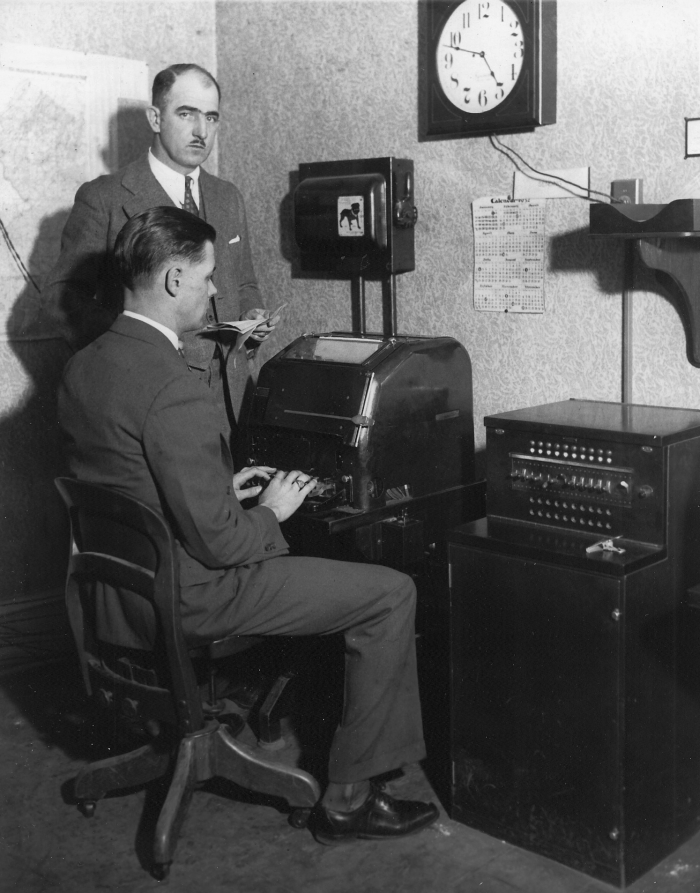
| Teletype Machines 1932 |
| Baltimore Sun Archive Photo |
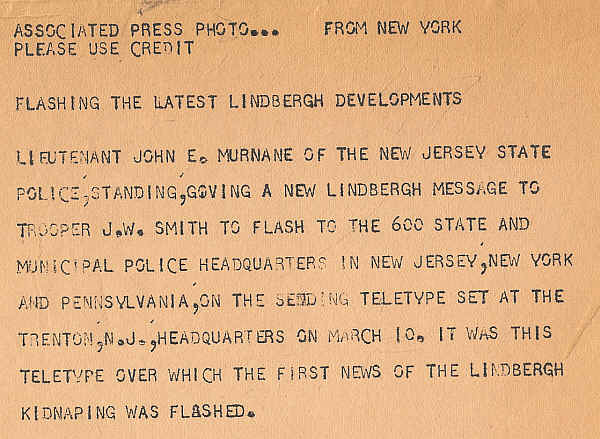
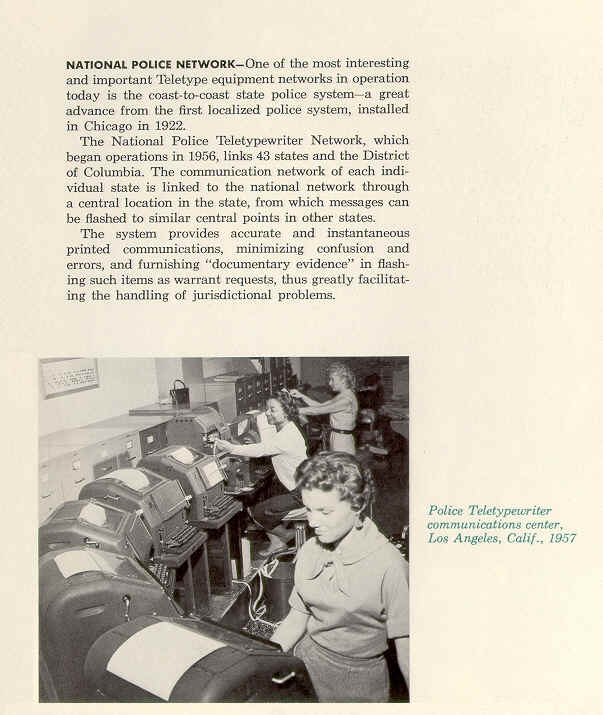
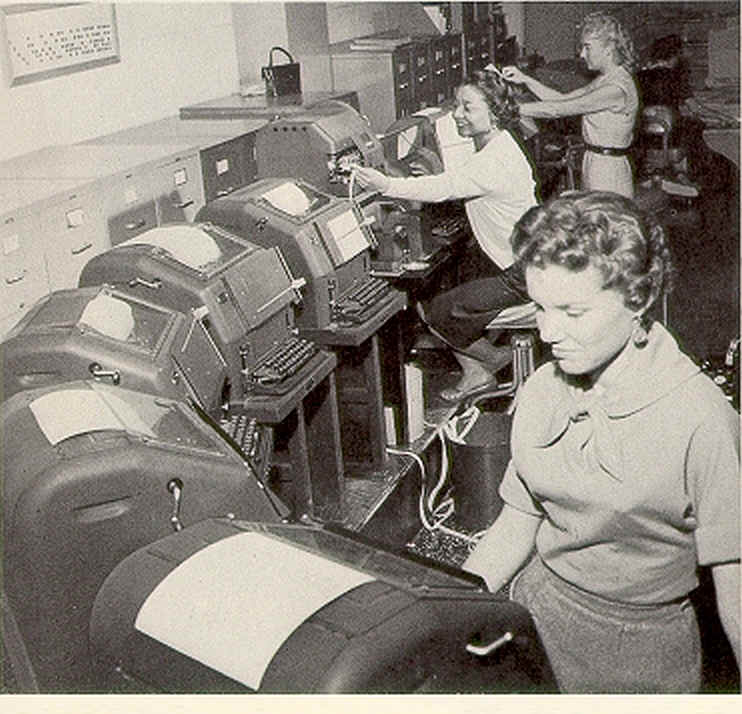
NATIONAL POLICE NETWORK - One of the most interesting
and important Teletype equipment networks in operation
today is the coast-to-coast state police system-a great
advance from the first localized police system, installed in
Chicago in 1922.
The National Police Teletypewriter Network, which began
operations in 1956, links 43 states and the District of
Columbia. The communication network of each individual
state is linked to the national network through a central
location in the state, from which messages can be flashed to
similar central points in other states.
The system provides accurate and instantaneous printed
communications, minimizing confusion and errors, and
furnishing “documentary evidence” in flashing such items as
warrant requests thus greatly facilitating the handling of
jurisdictional problems. (From
THE TELETYPE STORY - 1958)
There is a long history of teletypewriter use by police organizations.
Recently photos of TTY equipment in old police operations have been
offered on ebay.com One mention of police service in the Eastern U.S.
is given in a paper "Modern Practices in Private Wire Telegraph Service"
by R. E. Pierce of AT&T, AIEE Transactions, June 1931, p. 426.
Circa 1960 Teletype had a switching system called TASP that I was told
was marketed primarily to police departments. Some patents describing
this system are 2,625,601 (1953) and 3,251,929 (1966). It's curious that
Teletype offered such a system, since switching arrangements were usually
considered to be on Bell Labs' turf. (Or Western Union, for non-Bell
users) Teletype was allowed to do switching work for customers where
it was felt there was no general Bell System market. Therefore I assume
TASP was marketed to police (and other agencies) that wanted ownership
of the equipment rather than a leased service.
When amateur RTTY first got started in the late 1940s the majority of
Teletype machines available to amateurs were Model 12 page printers,
and most of them seemed to come out of New York. I remember reading
somewhere that most of them had come out of the New York police
department. The NYPD had replaced its tty machines out of necessity
when Teletype quit making maintenance parts for them.
jhhaynes
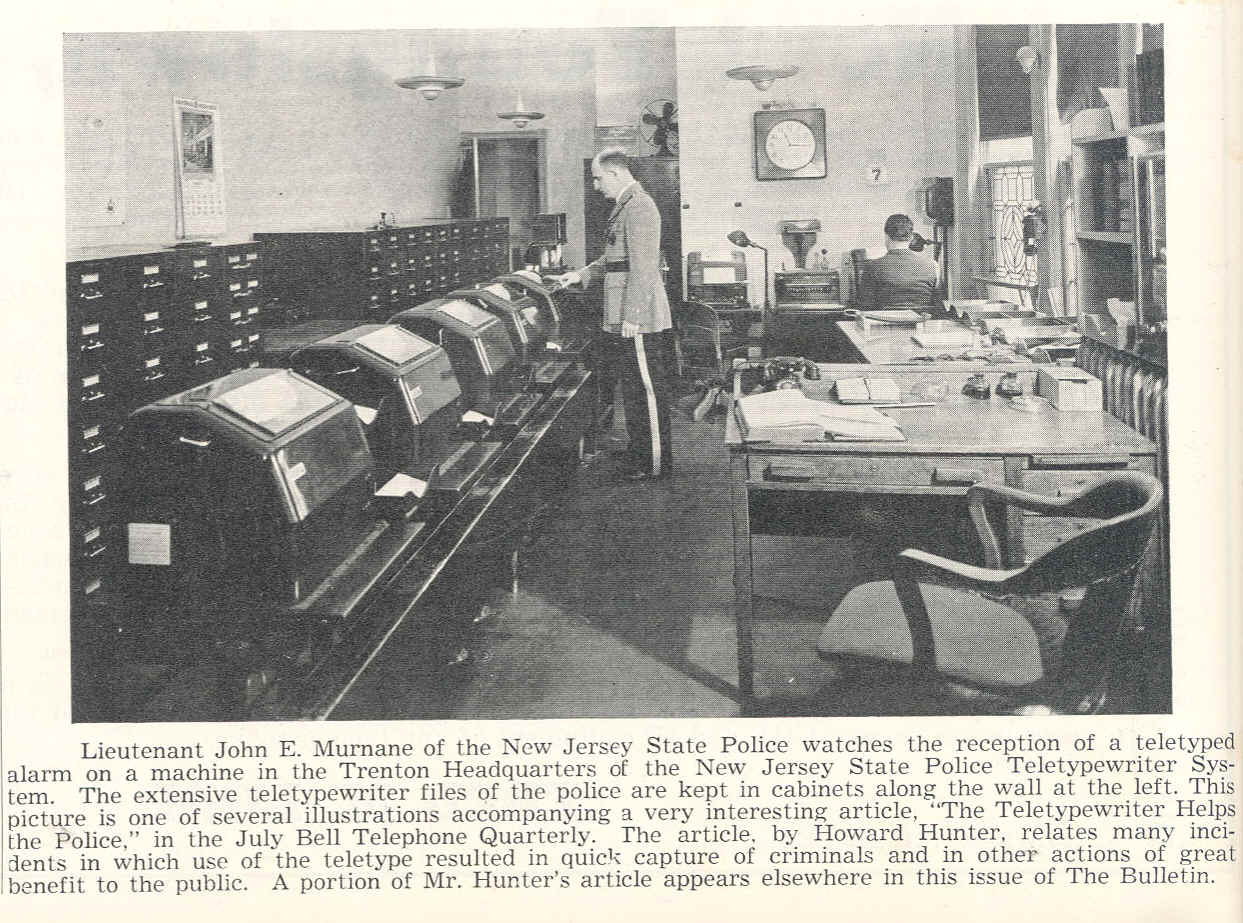
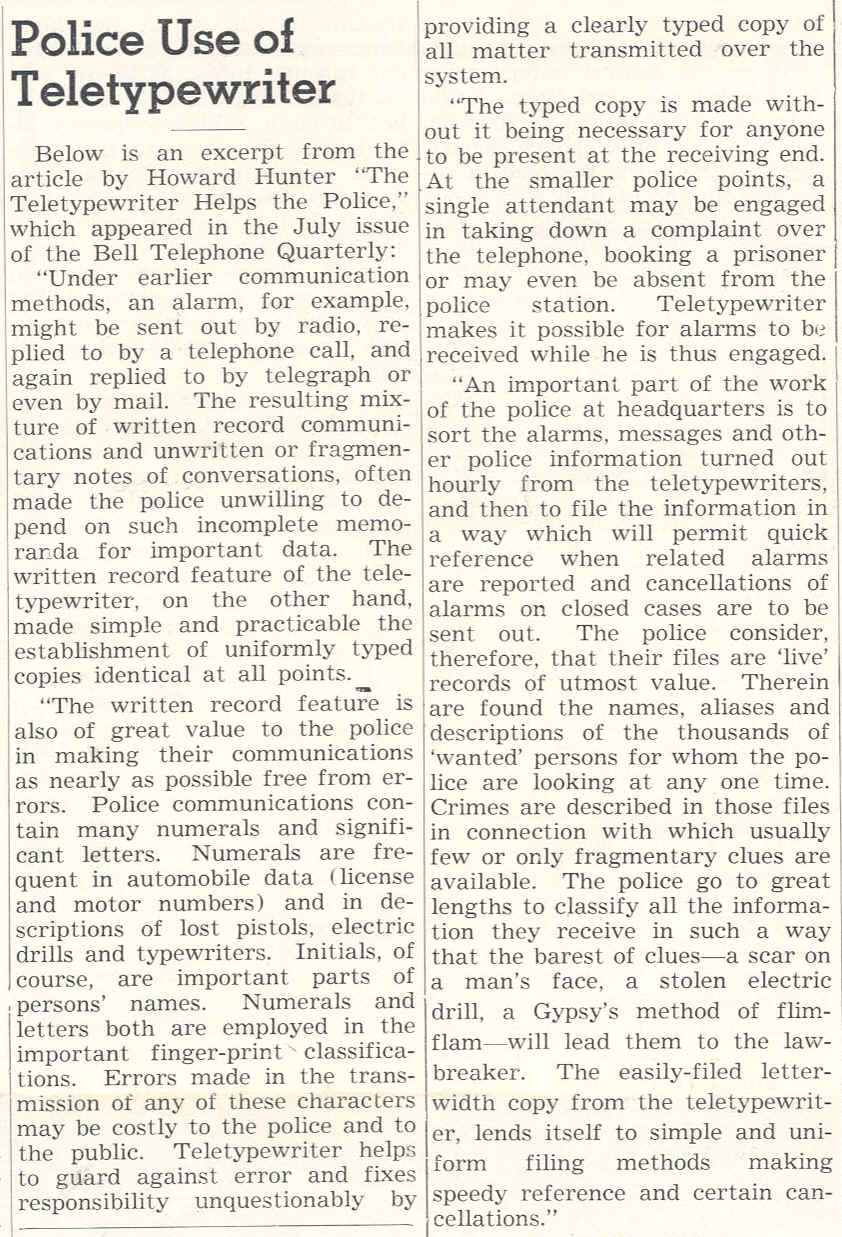
|
| |
| Communications and Police Protection
Bell Telephone Quarterly JANUARY
1936 -John C. Steinberg 3
EVERY invention, while adding to the comfort or welfare
of society, introduces its own peculiar problems. We
think of rapid transportation, for example, as a boon to mankind.
Primarily, it is; but, at the same time, those who refuse
to conform to society's rules of conduct make of it an aid to
the law-breaker. The modern criminal employs the speedboat,
the airplane, especially the fast motor-car and our hard
roads as means to accomplish his own ends. He has greatly
shortened the time it takes him to escape from the scene of a
crime.
While speed has been added to the kit of the up-to-date
criminal, science, fortunately, has been able to answer this
speed with more speed. Invention keeps a pace ahead of the
enemies of society. The evil-doer knows that, whereas a few
years ago half an hour or longer might elapse before a policeman
put in his appearance, it is now likely to be a matter of
only a few minutes before a dozen or more officers of the law
reach the scene. Escape time has been greatly reduced. And
this diminution has been brought about chiefly by agencies of
communication - the telephone, the teletypewriter and the
radio, along with improved techniques for their application to
law enforcement.
With time having become so important an element in the
apprehension of criminals, it is essential that the public cooperate
with police forces in order to secure the maximum of
protection. None is more aware of this fact than the police
official. Constantly, police departments urge citizens not to
delay in reporting to headquarters not only crimes which are
witnessed but suspicious persons or circumstances. The New
York City Police Department recently distributed 100,000
13
posters, appealing to the public to " Phone the Police." The
faster a report goes in to headquarters, the faster police departments
can swing into action, thus cutting down " escape time "
and making an arrest more probable.
In general, it may be said that there are three types of police
communication. First, there is the telephone. With its 87,-
000,000 miles of wire, its army of trained, alert workers motivated
by the traditional Spirit of Service, the telephone system
offers the means of making the quickest possible contact between
the public and the police. When you say to the operator
" I want a Policeman " you have taken the first necessary
step in law enforcement.
To the police forces the telephone is indispensable. Not
only do their switchboards handle the many calls from the
public but countless messages from one police official to another
go over the board.
As the police go into action in the war against crime, not
only the telephone but the teletypewriter and the radio come
into play. The telephone, the teletypewriter and radio, all
three, are swift, practical and dependable; but, the teletypewriter,
with its printed record, its duplicate copies, its ability to
receive messages at unattended stations, its secrecy and its
power to communicate simultaneously with many points over a
wide area, offers features of special value to law enforcement
bodies, and, accordingly, forms the basic system in a modern
police communication network. For establishing contact over
a limited area between headquarters and mobile police units,
such as automobiles, radio is proving of increasingly great
value. Captain Albert B. Moore, Inspector of the New York
State Police and Director of the New York State Police School,
who is in command of the state police teletypewriter and radio
systems, emphasizing the value of these services in a recent talk
in Richmond, Va., said:
" Police information to be of value must of necessity be accurate.
Any errors in transmission might result in serious com-
14
plications. The accuracy must be supplemented by rapidity
of transmission, and the rapidity of transmission must place
the information at all points within a given area simultaneously
in order to be of value. Criminals leaving the scene of their
operations may depart in one specific direction only to change
their course, and perhaps double on their tracks. It is therefore
obvious that all directions of the compass must be considered
in the hunt for these malefactors. . . .
" Many times I have been asked concerning the value of
radio for police work. I believe it is valuable and has its place
in any well organized communication system. Radio presents
possibilities for limited areas, but in New York state it would
be practically impossible to have one radio system capable of
reaching throughout the entire state. There are several municipal
police stations and these are having highly successful
results. However in a broad area, such as New York [state],
radio must of necessity be supplemental to teletypewriter."
August Vollmer, criminologist and former president of the
International Association of Chiefs of Police, writing (with Alfred
E. Parker) on " Crime and the State Police," says of teletypewriter
systems and other modern instruments in use by the
police: " It is this modern equipment in well-trained hands
that often enables the State Police to be so effective against
modern criminals. Perhaps this is nowhere so evident as in
the use of quick means of communication. . . . The teletypewriter
system as installed by the New York State Police is an
outstanding achievement in State Police communication."
The best equipped police forces today employ to advantage
all three forms of communication.
Teletypewriter Service
Simply expressed, a teletypewriter is an electrical device for
typewriting by wire. Perfected in 1915 (when it was known
as printing telegraph equipment) it has been continuously improved.
Today, including machines for both private lines and
15
switched service, some 1,200 teletypewriter stations provided
exclusively for police purposes are actively in use in the United
States. This number is rapidly increasing.
Since 1927, when various municipalities in Connecticut began
to use a private line teletypewriter system, the importance of
the device in police communication systems has steadily grown.
On December 23, 1929, the first state police teletypewriter
system was inaugurated by Pennsylvania. On October 1,
1930, New Jersey inaugurated a state-wide system, and provided
for the first interstate connection, which was between
New York City, New Jersey and Pennsylvania. In 1931 as a
demonstration there was established by private wire a police
teletypewriter hook-up of 7,000 miles, involving twelve states,
a Canadian province and fifteen cities scattered from New York
to the Pacific Coast. About a year and a half ago, the state
of Connecticut completely revamped its system and established
it upon a state basis. In the meantime, a cooperative movement
among the states in the east had been growing. The
need for rapid communication from one state system to another
had become apparent. Out of this need there developed an
eight state regional system which furnishes teletypewriter coverage
to the states of New Jersey, Pennsylvania, New York,
Connecticut, Massachusetts and Rhode Island with connections
to Delaware and Ohio.
It is easy to see how lessened has become the chance for the
criminal to escape in this large area, for it is possible over the
eight state hook-up for a state to flash almost simultaneously a
report on a crime to each of its teletypewriter stations and to a
police point in a neighboring state, where the report may be retransmitted
to other cities and eventually to other states. Full
coverage of the eight states for a police alarm is obtained in this
way in less than 20 minutes. Furthermore, plans are under
consideration for the establishment of teletypewriter systems
in a number of adjoining states. When these are connected,
as planned, with the existing regional system, there will be no
16
longer merely an extensive eastern teletypewriter network but
the beginning of a truly national system.
The municipal teletypewriter system may vary from a few
sending and receiving machines to the 136 in New York City.
The teletypewriter system of the Police Department of the
City of New York is, naturally, complex. The greater city is
divided into five boroughs—IManhattan, Brooklyn, Bronx,
Queens and Richmond. For each borough there is a separate
police command with a headquarters office. In each borough
headquarters there is a switchboard with tie-lines which permits
two-way service between general police headquarters in
Manhattan and the other four boroughs. Associated with the
switchboards are a total of 136 teletypewriters. This flexible
system provides that messages may be sent to any single teletypewriter
machine, to a group of machines or to all machines
connected with the switchboards; it furnishes two-way communication
between general headquarters and the other four
borough headquarters, as well as one-way communication between
each borough headquarters and each precinct in the borough.
Two classes of information are transmitted over the
system: first, that of general importance which is transmitted
by general headquarters to the other boroughs where it is
widely distributed when the precincts are involved; second,
that which concerns a particular borough. The information
thus transmitted originates from communications received at
headquarters from precinct, division or district commands, or
from reports from the public.
A good example of a county system is that which serves the
police of Nassau County. It is not only useful in the work of
protecting all sections of the townships not included within the
limits of incorporated villages (in certain instances incorporated
villages are patrolled also) but, as it is tied in directly
with the New York City police teletypewriter system and the
New York State system, it is one unit in a regional network.
The county police department is divided into six precincts
17
with headquarters at Mineola. The system consists of a 20-
line switchboard at Mineola from which two-way circuits are
extended to each precinct headquarters, terminating in receiving
and sending instruments. The switchboard is so arranged
that the operator may send or receive messages to or from any
station connected with the switchboard. Messages may also be
sent simultaneously to a selected group of stations or to all stations
in the system.
With the New York City system, the Nassau County system
is connected by two one-way circuits. The circuit from Mineola
to New York City terminates in a receiving only machine
at Manhattan headquarters, while a circuit from Manhattan
headquarters terminates in a receiving only instrument at
Mineola.
These municipal and county systems are, generally, connected
with each other and with the state systems and are tied
in by direct teletypewriter circuits with the systems of neighboring
states. In many instances, they are supplemented by
strategically located police radio stations.
The state of New York dispatches over its teletypewriter
system more than 250,000 communications each year. Of
these, about fifty per cent are concerned with automobile registrations
and requests for data, stolen cars, recovered cars, hit
and run drivers and emergency notices to automobilists. Another
ten per cent is accounted for by reports on missing persons,
with about forty per cent devoted to the more spectacular
misdeeds and routine administrative business. The dramatic
crime is relatively rare. Its scarcity may be due somewhat to
the preventive factor present in modern police communication
systems. Police officials are convinced that the knowledge of
the existence of modern communication equipment in a given
area acts as a crime deterrent.
The teletypewriter is admirably suited to the handling of
that vast amount of police business of which the public does
not hear. In many cases, an instrument is stationed in the
18
state's motor vehicle bureau so that data needed by the police
can be obtained promptly and reported back.
Most police teletypewriter systems are set up on a private
line basis. However, a certain limited use of Teletypewriter
Exchange Service has developed since 1931 when the latter
service was introduced.
One of the most interesting of recent installations is that of
the Federal Bureau of Investigation of the U. S. Department
of Justice. Teletypewriter Exchange Service (familiarly
known as TWX) was placed in operation in 1935 for communication
between the Bureau's Washington headquarters
and its 36 field offices located in other strategic cities throughout
the country. There are four machines in the headquarters
office at Washington, two each in the New York, Chicago and
Philadelphia offices, and one each in the remaining field offices.
When the Bureau's Director, J. Edgar Hoover, or a member
of his staff in Washington wants to communicate with the field
in which are operating 500 specially trained men—the famous
" G-men "—the procedure is somewhat as follows:
In the communications section of the Bureau in Washington,
one of the men assigned to the work throws a switch on one of
the machines. When the TWX operator indicates that she is
ready, the Bureau operator types, let us say, Denver 0711.
When, a few moments later, a bell rings in the Denver office
there will be some one on duty to handle the call, for all the
field offices, in charge of special agents, are open day and night.
The field operator establishes connection and the Denver
machine is ready to reproduce the message typed in Washington.
Again, Washington may want to be in touch with all 36 field
offices at one time. There may even be additional temporary
offices with which headquarters wants to communicate while
addressing the field. Swiftly, Bell System operators go into
action. Following a carefully formulated plan, they set up a
conference TWX circuit linking the Washington office, over
19
hundreds of miles of wire, with every field office. In less than
half an hour, every teletypewriter in every field office is simultaneously
clicking off the Washington report. The communication
may have to do with a matter of administrative routine,
with a robbery or a kidnaping, with any one of hundreds of
crimes to which the G-men may be assigned.
The Bureau, of course, makes extensive use of the long distance
telephone. Its speed, privacy and suitability to personal,
two-way discussion commends it. When, in addition to speed,
privacy and the two-way channel, it is desirable that the message
be transmitted in written form, TWX service efficiently
meets the need.
The following actual case is a good example not only of cooperation
between different police organizations but of the
value of the teletypewriter in spreading information quickly
over a wide territory.
Four men broke into a jewelry shop in Beacon, N. Y. Local
police surprised the thieves and managed to catch one. The
other three escaped in an automobile, taking the road for New
York. Immediately a message was dispatched over the state
teletypewriter system by the State Police at Fishkill. The
robbers were sighted once again on their dash southward and
an added alarm was teletyped concerning them. By the time
the fleeing thieves reached Yonkers, practically every peace
officer in the county and every police officer in New York City
was on the lookout for them, having been warned by teletypewriter
messages relayed by radio to patrol cars or by telephone
to call-boxes.
Charles Smith, Westchester County Parkways patrolman,
encountered the robbers in Yonkers. He waved them to a stop
but they answered by firing their revolvers at him. Smith
gave chase on his motorcycle and forced the speeding car into
a ditch.
A hand to hand combat ensued. Smith caught one of the
20
trio, but the other two broke away and, commandeering a taxicab,
started once more for New York.
The taxi-cab was halted finally by New York City police.
Once more there was an exchange of revolver shots. This time
the police killed both the bandits.
Another actual case, in which telephone, teletypewriter and
radio dove-tailed, is that of Robert J. Mahoney who shot State
Trooper George Doring in Sudbury, Mass. Five hours later,
Mahoney was dead in Leicester, Mass. Trooper James H.
O'Neill had brought him down.
Trooper Doring had called on Mahoney to halt. Mahoney
replied by firing at him and wounding him. The gunman, a
girl beside him in his car, roared down the road toward Worcester.
" Within five minutes after the shooting of the policeman," said the
Worcester Telegram, " the Framingham barracks of the state police had
established contact with troopers on patrol. Two men were assigned to
watch the Post road and question all persons answering the description
given. One trooper was posted near the scene of the attack. . . . Garages
and call stations were notified to flag all the passing troopers and to direct
them to call in immediately.
" Automobiles equipped with radio receiving sets were immediately contacted
as they cruised through the Lake Boone region. Those troopers
learned of the crime within ten minutes of its occurrence.
** The teletype switch was throwwn open and a white light glowed over
' Framingham ' on the switchboard in the State House headquarters of the
State police patrol. An operator pulled a switch on the teletype machine
and a policeman in the Framingham barracks began his story. The story
was in cold type almost as soon as one could tell it. The operators threw
down the plugs to Holden, Middleboro and Northampton. Over the
wires to these stations went the news of the shooting.
" At Framingham the telephones rang loudly as the troopers called in
from garages and call stations. Nine men were ordered to Worcester to
find the missing bandit and bring him back. They started for Worcester
while 23 men whirled out of the substations at Reading, Concord, Topsfield
and Wrentham. ... In the meantime at Holden the teletype was
grinding out its story."
21
From the north, east, west and south the troopers came,
called by the teletypewriter, telephone and radio. Finally, a
hundred men were involved in the hunt. The bandit was
bottled up somewhere near Worcester. Every avenue of escape
was closed. It was only a matter of time before Mahoney
was caught.
At Spencer the engulfing waves of troopers met. Mahoney
was surrounded. He wrecked his car against a stone wall, injuring
his girl companion, and took to the woods, alone and on
foot. He ducked and dodged. He tried to steal a truck and
failed. From another truck he got a short ride. At Leicester,
he was on foot again, crawling through back-yards. He
climbed the fence at the Leicester Tavern. Trooper O'Neill
of Holden saw him. He called to him, then fired. Mahoney
toppled. O'Neill went after him. Lieutenant Shimkus and
Sergeant Sullivan ran up. Mahoney had crawled to a cellar,
leaving a trail of blood. Shimkus called on him to surrender.
The bandit, his voice choking, refused and fired at the officer.
The Lieutenant rushed upon him and disarmed him. Mahoney
lost consciousness and died half an hour later.
In the words of the Worcester Telegram: "A bullet killed
him, but radio and teletype and telephone had already doomed
him."
Since 1921, when the Detroit Police Department began its
experiments, an increasing number of law enforcement units
have been making use of radio. At the close of 1935 there
were in operation more than 60 city, county and state Western
Electric Police Radio Systems, as well as others manufactured
by other companies, all of them getting cars full of police officers
to scenes of crime within two or three minutes after the report
had been received at headquarters. Police radio is giving
added protection to 35 million people.
22
|
Two-Way Police Radio
In the spring of the same year, Bell System engineers contributed
to the war against crime one more important weapon.
This is a Two-Way Police Radio, a great advantage to peace
officers in a limited area. With this equipment, the motor
patrolman not only receives alarms but he may acknowledge
them, request further instructions, report crimes or suspicious
persons or circumstances, may inform headquarters of his position
and progress on an assignment—all, without leaving the
wheel of his car.
The first installation of the new system was in Evansville,
Indiana. Westfield, N. J., Morristown, N. J., Manchester,
N. H., Elgin, 111., Wheeling, W. Va., and Nashville, Tenn., are
scheduled to have two-way equipment in operation in the near
future.
Statistics covering five months of operation in Evansville are
startling. They reveal a decrease in crimes of 17 per cent and
an increase in arrests of 60 per cent, following the introduction
first of one-way and later of two-way police radio.
The two-way system operates on ultra-high frequencies in
the band of 30-42 megacycles. In addition to a transmitter
at headquarters and receivers in the patrol cars, it includes
specially designed transmitters for the cars and a receiver at
headquarters. The car transmitters, weighing only 20 pounds,
are only 11 by 7 by 6>4 inches in size and yet are held to within
.025 of an assigned frequency by a new type of crystal with a
low temperature coefficient.
A flexible steel rod, projecting slightly above the top of the
car, acts as a vertical antenna which transmits as well as receives.
On the dashboard hangs a telephone, much like the
familiar hand-set, and the patrolman's voice speaking through
it operates relays which put the car transmitter on the air.
These relays are so timed that they do not switch off during
intervals between words but do so after the brief pause which
23
shows that the speaker has finished. The car receiver then
automatically goes into operation and is ready to pick up messages
from headquarters.
Most police radios operate on a medium frequency band,
roughly from 1,600 to 1,700 kilocycles and from 2,300 to 2,500
kilocycles. With an eye to the crowding that might take place
within that narrow range, the Federal Communications Commission
recently assigned to police work experimentally, an
additional band which ranges from 30,000 to 42,000 kilocycles.
The system of the Police Department of the City of Newark,
N. J., among the most up-to-date one-way installations in present
use, operates in the new high frequency band on 30,100
kilocycles.
For municipal stations, there are certain advantages in ultrahigh
frequency operation. Freedom from atmospheric disturbances
is one. No static, or thunderstorms will trouble the
ears of the motor patrolmen.
As wave length determines antenna length, Newark is able
to employ a short section on the 100 foot flag pole atop the
city's tallest building, the National Newark & Essex Bank
Building. Conversion to two-way service would, should authorities
determine upon it, be very simple as the car transmitters
could operate on the wave length which the station now
uses. Short waves do not carry great distances from such
stations. For State Police work two-way radio, because of
limited range, is not now developed so as to be practical. The
limited range has an advantage, however, in that a city as close
to Newark as Albany probably could use the same wave length
without overlapping. However, as the separation between
ultra-high frequency channels is very narrow all apparatus, to
perform successfully, must be of great refinement, stability,
selectivity and reliability.
Put into service on October 3, 1934, by Director of Public
Safety Michael P. Duffy, the radio branch of the Newark Police
Department has made enviable records not only in efficient
24
law enforcement but in overhead cost reduction. Said the
Newark Ledger recently:
" The radio division has made 849 arrests, extinguished 55 fires, saved
more than 40 lives and recovered stolen property valued at ?1 15,002. . . .
" In 1931 there were 110 more men in the police department than there
are today. Radio made it unnecessary to replace them upon retirement.
Figuring on a base pay of $2,300, saving of their salaries means more
than $250,000 in the annual running expense of the police division.
" In addition Duffy was able, due to the wide scope that one car can
handle, to abandon four police precincts.
" Several months ago, the director shut down the Fifth, Sixth, Seventh
and Eighth Precinct Station houses. * These properties will be put on
sale when the real estate market improves,' Duffy said.
" ' That means the property will once more become taxable and will
show in the ratables.'
" Case records kept by the radio division tell an interesting, important
tale.
"'On Nov. 8 at 1:44 P.M., car 42 was sent to 52 Littleton Avenue,
where a thief was ransacking the premises. The house was covered front
and rear and a radio patrolman entered the front door and arrested the
burglar. At 1:48 P.M., a patrol wagon was summoned to take the prisoner.
The man has a criminal record.'
"'On Dec. 11 at 10:15 A.M., car 52 noticed smoke coming from a
house on North Seventh St. A patrolman entered the building and
brought a 90-year-old man and an infant to the street in safety. In
doing so he was overcome by smoke and received treatment at City
Hospital.'
" ' On Dec. 6 at 11:43 P.M., two cars were sent to a Sumner Avenue
building where a woman was about to commit suicide by leaping from
the roof. Car 22 arrived at 11:45 P.M. and took her from the roof in
safety.'
" ' On Nov. 18, radio car 52 noticed auto parked near Bloomfield city
line. Two men were in car. Officers investigated and found car contained
sawed-off shotgun, an automatic revolver, and burglar tools. The
men admitted a plan to hold up a gas station.'
" These are only a few of the tasks the radio men have performed successfully."
A review of recent developments in methods of exchanging
intelligence among law enforcement units, indicates that to
25
the constant war against crime the art of communication has
made two most valuable contributions. First, through virtually
universal telephone service it enables the public quickly
to give an alarm. Second, through teletypewriter and radio
it allows the authorities to take rapid action upon the receipt
of the alarm and, if need be, to spread information far and
wide with little or no loss of time.
To the long arm of the law has been added a voice. And
that voice, whether it be the 24-hour a day chattering of the
teletypewriter, the staccato bark of the radio or the familiar
ring of the telephone, is daily putting fear into the hearts of
criminals and making life safer for the public.
Sterling Patterson
26
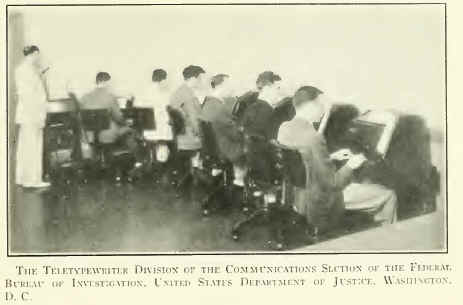
The TtLETVPEwraTF.R Division* of the Communications Section of the
Federat,
BiREAu OF Investigation, United States Department of Justice, Washington,
D. C.

N. Y. DAILY news PHOTO
Captain Albert B. Moore, Communications Officer of the New York State
Police, Addressing a Conterence of Police Officials on Teletypewriter Techniques.
Lieut. Kinsey of the Ohio State Hic.hw.ay P.^trol is Presiding.

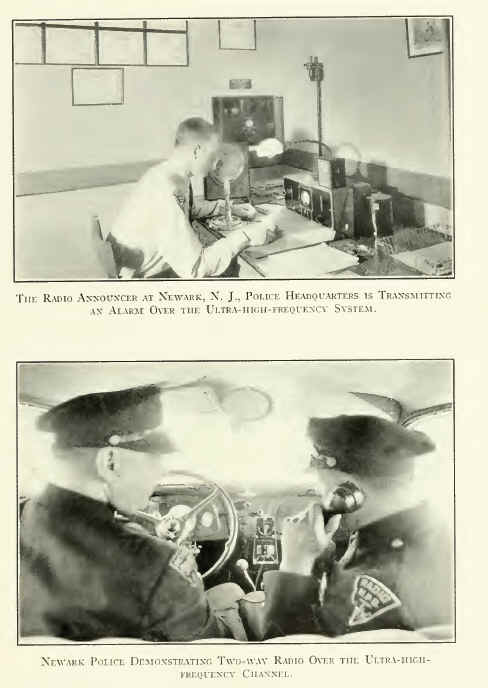
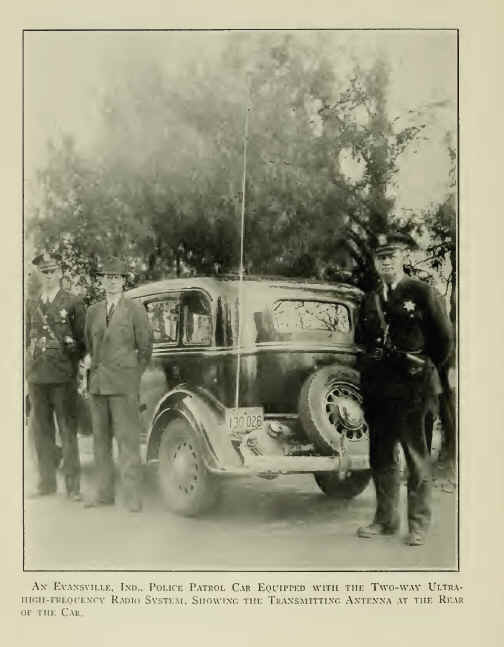
Ax Ev.\Ns\ II i.K, Im).,
Police Patroi. Car Equipped
with iiii.
Twu-ww Ui.tra-
HIGH-FREQIIENXY RaDIO SySTEM, SHOWING
THE TRANSMITTING AnTENNA AT THE
Rf.AR
OF TiiK Car
|
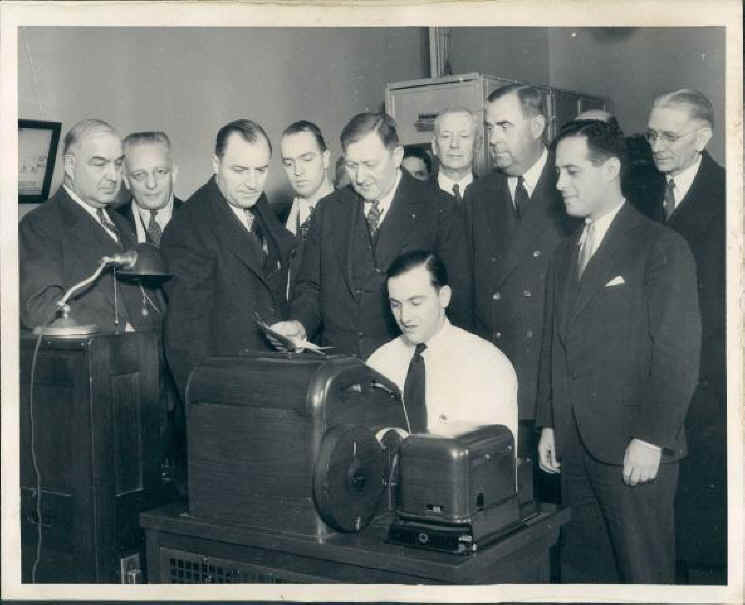
1935 Police Demonstrate
Teletype
|
| |
|
|
telephones to his local police department and reports that his
automobile has disappeared. He tells the police the make,
year, color, and the license and motor numbers of the car. A
police officer types out the alarm on the keyboard of the teletypewriter.
The keyboard is similar to that of an ordinary
typewriter and as each letter is depressed at the home machine,
the corresponding letter is typed on all other machines which
may be connected to the circuit. The copy thus typed out (at
speeds up to 60 words a minute) is letter width size, and frequently
the machines are arranged to provide carbon copies at
some of the larger police points where extra copies of alarms
and reports are of advantage to specialized police groups, such
as the automobile, homicide and missing persons squads.
The alarm thus typed out reads as follows:
STOLEN CAR, REGISTRATION B-12974 BUICK 1938 SEDAN,
BLACK, MOTOR NO. 9870482.
This alarm, when it is received at the headquarters of the
state system is consolidated with other stolen car alarms and
the combined information started on its way to points throughout
the state and to the other states in the network. Key
points in the neighboring states receive the various alarms.
The key points in turn spread the alarms throughout their own
states and to other states to which there are teletypewriter connections.
County and city systems carry the report to precincts
and station houses. The information as to the stolen
car may in this way be known within 15 minutes to detective
bureaus, automobile and traffic squads, Motor Vehicle Bureaus
and State Police troopers throughout the eight states.
When the state police stations receive an alarm over the
teletypewriter system, they post the car number in the barracks
where the troopers may take note of it as they come from or go
on duty. Municipal police units note the alarm on the " blotter."
The alarm is read to the shifts next going on duty together
with other alarms, police reports and instructions. Men
169
detailed for traffic duty jot down the car numbers contained in
the alarm before they go on shift. Motorized traffic police
sometimes carry the information, given by the alarm, on a card
placed under the transparent backing on one gauntlet, or the
original teletypewriter copy may be carried in this way. When
the hand is raised to halt a car, the wanted car number is in
easy line of sight with the license plate of the stopped car.
Besides being telephoned to other police points, the teletypewriter
alarm may be passed to motorcycle officers through the
device of telephoning roadside gas stations, dining places or
refreshment stands, to " flag " the officer to stop and receive the
message. A ''disk" or flag sometimes is displayed for this
purpose. State and municipal police points equipped with
transmitting equipment, relay the teletypewriter alarm by
radiotelephone to police in automobiles in the city and on the
highways.
Reproductions of several police alarms are shown herewith in
illustrations and in the text. While the alarms are actual
police records, the names of the people concerned have been
deleted and wholly fictitious names substituted in their place.
PoiNT-To-PoiNT Police Information
In addition to the flow of alarms to all points, the various
state-wide police teletypewriter systems carry many criss-crossing
queries and answers as clues are hurriedly sought, suspects
examined and " tips " passed from one police force to another.
Speed is again the important thing in this traffic. Some of
the thousands of such messages read as follows:
Information please on 4NY19-18.
Please forward fingerprints of Van Doran killed by Capt. Williams
of your department during holdup. We have several chain store robberies
and would like to check on this man.
170
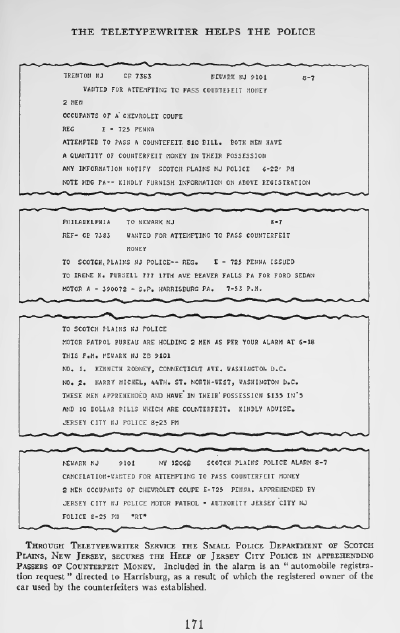
Be advised that the Russell Kelley wanted by you may be in possession
of a Packard Coupe color gray registration E-45909 on door are
initials " R. J. J." Stolen from this city March 30.
"Look-ups" directed to automobile bureaus, such as the
first message illustrated above, result in replies which give
to the police information as to the make, color, year, model,
engine and serial number of the the cars bearing the indicated
license numbers. These records also show which cars have
been reported stolen. Forgeries of automobile registration
certificates, transferred license plates and mutilated engine or
serial numbers can thus be detected almost immediately. Similarly
the police send requests for " look-ups " to the motor
vehicle bureau for data on the holders of motor vehicle driving
licenses. Forged operators' licenses are easily detected and
frequent offenders readily identified through these requests.
Private line teletypewriter service is a direct path into the
motor vehicle and police departments connected to the system,
for the exchange of this kind of information.
Finger-Print Records
The value of the rapid transmission of fingerprint information
between police departments is one whose importance is
clear to all. That this information may be transmitted by
teletypewriter is not, however, generally known. Letters and
numerals are used to describe the characteristic form and number
of the lines in the print of each finger; for example, U and
R indicate, respectively, the fingerprint "ridges " flowing in the
direction of the ulnar and radial bones of the arm, while the
figures designate the number of these ridges which may be
counted between certain reference points in the print. A substantial
use is made of the eight-state system for spreading
alarms containing fingerprint information. The following is a
fingerprint record as transmitted over the police teletypewriter:
172
THUMB INDEX MIDDLE RING LITTLE
RIGHT U-11 U-9 U-12 R-8 U-10
LEFT R-5 R-10 U-12 R-11 U-9

Coordination with Other Communication Methods
The police use various other communication methods to
spread alarms. The use of radiotelephone to flash alarms to
police cars from headquarters has already been mentioned.
There is also an exchange of alarms between the police on the
Eight-State Teletypewriter System and radiotelegraph stations
of the police located in several mid-west cities. This exchange
is carried out by the municipal police department at Buffalo,
New York.
The police also make a wide use of the telephone for communication
with points not connected to the teletypewriter
network. Police points receiving alarms via teletypewriter,
frequently relay these alarms to other strategic non-teletypewriter
points by telephone. An instance of the use of the
telephone in this way, was the arrest of the robbers of the Bank
of Katonah, N. Y., when the police of the small village of
Armonk, N. Y., 15 miles away, acting on a telephoned alarm,
dragged the wanted men from under the rumble seat cover of an
automobile and recovered a paper bag containing $18,000 taken
from the bank a half hour earlier. Small police departments
without teletypewriter service, or equipped only with teletypewriters
for receiving, often telephone in their alarms and requests
for information to a two-way police teletypewriter station,
at which point the communications are transmitted over
the state-wide system. The New Jersey State Police zone
headquarters at Newark handles annually upwards of 39,000
such requests from the police of 60 neighboring communities.
The telephone is also used to take advantage of the quick, personal
contact afforded by this form of service in those matters
which require discussion and interchange of views between
police officials.
173
Telegraph message service is also used by the police, as for
example, when the police of distant cities are to be informed of
arrests which have been made, especially those made as a result
of an alarm sent out by the distant department. Data as to
criminal records and fingerprints are also often furnished in
this way. Missing persons from the smaller cities are often
reported by telegraph to the police of the larger cities, such as
New York, Chicago and Los Angeles.
Teletypewriter Exchange Service, as already mentioned, is
sometimes used to communicate with the Federal Bureau of
Investigation in exchanging identification information. It is
also used to communicate with certain other police points in
states with no private line networks.
Mail is also used extensively for nation-wide broadcasts of
alarms, where descriptions of wanted persons are sent to thousands
of post offices and police departments.
Systematizing Communication by Teletypewriter
Under earlier communication methods, an alarm, for example,
might be sent out by radio, replied to by a telephone
call, and again replied to by telegraph or even by mail. The
resulting mixture of written record communications and unwritten
or fragmentary notes of conversations, often made the
police unwilling to depend on such incomplete memoranda for
important data. The written record feature of the teletypewriter,
on the other hand, made simple and practicable the
establishment of uniformly typed copies identical at all points.
The written record feature is also of great value to the police
in making their communications as nearly as possible free from
errors. Police communications contain many numerals and
significant letters. Numerals are frequent in automobile data
(license and motor numbers) and in descriptions of lost pistols,
electric drills and typewriters. Initials, of course, are important
parts of persons' names. Numerals and letters both are
employed in the important finger-print classifications. Errors
174
made in the transmission of any of these characters may be
costly to the police and to the public. Teletypewriter helps to
guard against error and fixes responsibility unquestionably by
providing a clearly typed copy of all matter transmitted over
the system.
The typed copy is made without it being necessary for anyone
to be present at the receiving end. At the smaller police
points, a single attendant may be engaged in taking down a
complaint over the telephone, booking a prisoner or may even
be absent from the police station. Teletypewriter makes it
possible for alarms to be received while he is thus engaged.
An important part of the work of the police at headquarters
is to sort the alarms, messages and other police information
turned out hourly from the teletypewriters, and then to file the
information in a way which will permit quick reference when
related alarms are reported and cancelations of alarms on closed
cases are to be sent out. The police consider, therefore, that
their files are "live" records of utmost value. Therein are
found the names, aliases and descriptions of the thousands of
" wanted " persons for whom the police are looking at any one
time. Crimes are described in those files in connection with
which usually few or only fragmentary clues are available.
The police go to great lengths to classify all the information
they receive in such a way that the barest of clues—a scar on
a man's face, a stolen electric drill, a Gypsy's method of flimflam—
will lead them to the law-breaker. The easily-filed
letter-width copy from the teletypewriter, lends itself to simple
and uniform filing methods making speedy reference and certain
cancelation possible.
Teletypewriter Helps in Many Types of Police Work
Improved results in police operations, attributable to the use
of teletypewriter, have strengthened police hands to the point
where crooks often think twice before deciding to rob a particular
bank, or gas station because troopers or other police
175
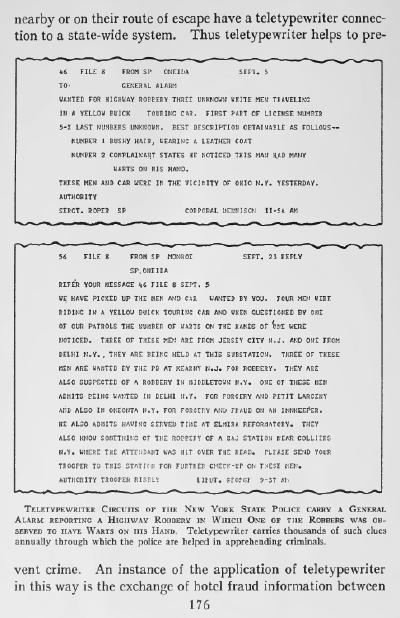
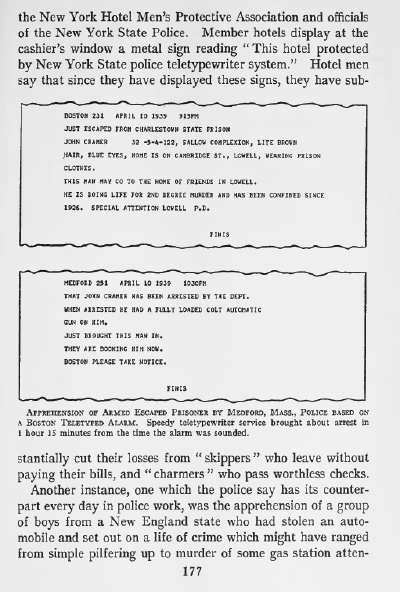
dant for the few dollars which could be obtained. In cases
like this one, the police are usually without information as to
the direction taken by the boys. Through rapid blanketing of
the eight-state area by teletypewriter, however, the police in a
nearby state were enabled to arrest the boys before they could
commit other and more serious crimes.
Turning to some of the work the police do which is of a noncrime
nature, the teletypewriter is found to enable police to
perform many additional services of great value to the public.
Some of these services could hardly have been rendered through
any other agency than the state police. In one such case from
the records of the police, in which again the blanketing value of
teletypewriter service was demonstrated, a baby's life was
saved from poisoning. The police alarm, teletyped in all directions,
was as follows:
8-State Alarm—please stop a Chevrolet car license G ^\V
Motor 8 , car is occupied by a man named C. E. B. with
his wife and baby. They took a bottle supposed to be medicine
contents of which was to be administered to the baby. The
bottle they have contains poison—1 per cent, atropine sulphate.
Poison bottle was taken by them by mistake please make every
effort to stop this car and warn them of danger. If supposed
medicine has already been administered to the baby use any
emetic as antidote.
An hour after this alarm had been sent out a patrol nearly a
hundred miles distant from where the error had been made
recognized the car. The " cancelation " which followed said
" Baby out of danger, only one small dose of poison administered."
Helen , a demented woman, visiting in a seaside resort,
had nearly asphyxiated herself and 5 children she had with her,
when police of a nearby state, acting on a teletyped alarm from
her home city nearly 200 miles away, broke into her boarding
house room in time to save all six lives. It had taken only an
hour for the police to find her. No one knew where she was.
178
THE TELETYPEWRITER HELPS THE POLICE
The police in her home city had sent the teletyped alarm in all
directions on the eight-state system. The police in the resort
spotted her parked car by its license number and a few inquiries
led them to her room in a nearby boarding house.
Agnes was identified by the police of a New England
city from information contained in a teletyped alarm describing
an amnesia patient in a hospital located in another State
in the system. Police who found her did not know where she
belonged, but the teletyped alarm to all police departments of
the eight states furnished the right clues to the proper authorities.
Other examples are given in the accompanying reproductions
of actual police messages. Used freely by the police
of all the connected communities, the eight-state system thus
aids the police in solving the innumerable routine cases which
form a large part of their day-to-day activity.
Teletypevi^riter Benefits from Police Cooperation
While teletypewriter and radio have been important factors
in making it possible for the police to cooperate actively, the
effectiveness of these communication systems is due in large
measure to the attention which the police officials in charge of
the systems have given to the many problems involved in exchanging
information between various states. In working out
suitable procedures for handling the interstate traffic, police
officials concerned with the operation of the eight-state network
customarily meet once a year for discussion of their
communication problems at a Teletypewriter Supervisors' Conference
in New York City. Many of these officials are also
members of the Associated Police Communication Officers,
a national body of police officials primarily concerned with
radio and teletypewriter communications. The two organizations
work closely together through joint committees established
for the study of traffic problems and the legal and other
179
questions looking toward the more expeditious and accurate
handling of police teletypewriter and other forms of communications.
In reviewing the place of teletypewriter service in police
work, it is evident that the police have need for an alarm distribution
system which will deliver alarms in volume, immediately,
over great distances and to a large number of police
departments. The broader such distribution is the greater is
the chance that the criminal will be apprehended.
With teletypewriter service the police now send their alarms
far beyond the range of earlier methods, almost instantaneously,
and to hundreds of places simultaneously. Police work
as a result has been made increasingly effective as the long
arms of the teletypewriter systems reach out to guard in an
ever greater area the lives and property of millions of people.
The teletypewriter in police hands thus is one answer to the
underworld's challenge to the safety of society, and an invaluable
aid in crime prevention.
Howard Hunter
180
|
| |




|
SOUTH DAKOTA TELETYPE STUDY
NCJ Number: 68867
Author: S FLYGER; L MERRICK
Publication Date: 1978
|
|
GET FULL>> PDF
Abstract |
|
POLICE TELECOMMUNICATION SYSTEMS
NCJ Number: 341
Author: ANON
Publication Date: 1971
|
| GET FULL>>
PDF
Abstract |
|
| |
|
































